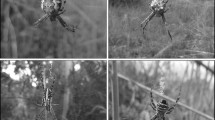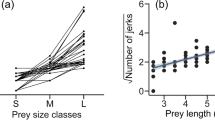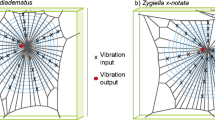Summary
-
1.
The spider orb web is a structure that both restrains prey animals and carries prey-generated signals to the spider. If spiders are to discriminate among prey items without risking movement in the open and contact with potentially dangerous prey, they must be capable of interpreting web-borne vibrational signals appropriately.
-
2.
To assess this ability in one araneid, the behavior of captive Cyclosa turbinata females as they preyed on five insect species was filmed under laboratory conditions. Analysis of the films showed that the movements associated with the spider's approach to live prey items varied quantitatively with prey type (Tables 1–4).
-
3.
The vibrations induced on the web by each of the prey species were recorded on magnetic tape and analyzed with respect to absolute amplitude, amplitude modulation, and frequency components. A comparison of C. turbinata's approach behavior with prey-typical vibrational differences revealed significant positive correlations (Figs. 1 and 3) and establlished a clear connection between the properties of web-borne vibrations and the behaviors elicited by them.
-
4.
An evaluation of the distinctiveness of the vibrations produced by each of the five prey species revealed considerable variability within species and broad areas of overlap between species (Fig. 4). This indicated that accurate prey discrimination by appropriate interpretation of web-borne vibrations is probably not possible on C. turbinata webs.
Similar content being viewed by others
References
Bendat, J.S., Piersol, A.G.: Random data: Analysis and measurement procedures. New York: John Wiley and Sons 1971
Bristowe, W.S.: The world of spiders. London: Collings New Naturalist 1958
Eberhard, W.G.: The web of Uloborus diversus (Araneae: Uloboridae). J. Zool. (Lond.) 166, 417–465 (1972)
Eisner, T., Alsop, R., Ettershank, G.: Adhesiveness of spider silk. Science 146, 1058–1061 (1964)
Ellis, J.E., Weins, J.A., Rodell, C.F., Anway, J.C.: A conceptual model of diet selection as an ecosystem process. J. theor. Biol. 60, 93–108 (1976)
Emlen, J.M.: The role of time and energy in food preference. Amer. Naturalist 100, 611–617 (1966)
Emlen, J.M.: Optimal choice in animals. Amer. Naturalist 102, 385–390 (1968)
Emlen, J.M., Emlen, M.G.R.: Optimal choice in diet: Test of a hypothesis. Amer. Naturalist 109, 427–435 (1975)
Finck, A.: Vibration sensitivity in an orb-weaver. Amer. Zool. 12, 539–543 (1972)
Frings, H., Frings, M.: Reactions of orb-weaving spiders (Argiopidae) to airborn sounds. Ecology 47, 578–588 (1966)
Harwood, R.H.: Predatory behavior of Argiope aurantia (Lucas). Amer. Midl. Natur. 91, 130–139 (1974)
Hingston, R.W.G.: Protective devices in spider's snares. Proc. Zool. Soc. Lond. 1, 259–293 (1927)
Kaston, B.J.: The evolution of spiders webs. Amer. Zool. 4, 119–207 (1964)
Kullmann, E.J.: The convergent development of orb-webs in cribellate and ecribellate spiders. Amer. Zool. 12, 395–405 (1972)
Langer, R.M.: Elementary physics and spider webs. Amer. Zool. 9, 81–89 (1969)
Liesenfeld, F.J.: Untersuchungen am Netz und über den Erschütterungsinn von Zygiella x-notata (Cl.) (Araneidae). Z. vergl. Physiol. 38, 563–592 (1956)
Markl, H., Wiese, K.: Die Empfindlichkeit des Rückenschwimmers Notonecta glauca L. für Oberflächenwellen des Wassers. Z. vergl. Physiol. 62, 413–420 (1969)
Murphey, R.K.: Sensory aspects of the control of orientation to prey by the waterstrider, Gerris remigis. Z. vergl. Physiol. 72, 168–185 (1971)
Peters, H.M.: Weitere Untersuchungen über die Fanghandlung der Kreuzspinnen. Z. vergl. Physiol. 19, 47–67 (1933)
Platnick, N.: The evolution of courtship behaviour in spiders. Bull. Brit. Arach. Soc. 2, 40–47 (1971)
Robinson, M.H.: Predatory behavior of Argiope argentata (Fabricius). Amer. Zool. 9, 161–173 (1969)
Robinson, M.H., Mirick, H.: The predatory behavior of the golden web spider Nephila clavipes (Araneae: Araneidae). Psyche 78, 123–139 (1971)
Robinson, M.H., Olazarri, J.: Units of behavior and complex sequences in the predatory behavior of Argiope argentata (Fabricius) (Araneae: Araneidae). Smith. Contrib. Zool. 65, 1–36 (1971)
Robinson, M.H., Robinson, B.: The stabilmentum of the orb web spider, Argiope argentata; an improbable defense against predators. Canad. Entomol. 102, 641–655 (1970)
Rudolph, P.: Zum Ortungsverfahren von Gyrinus substriatus Steph. Z. vergl. Physiol. 56, 341–375 (1967)
Schoener, T.W.: Theory of feeding strategies. Ann. Rev. Ecol. Syst. 2, 369–404 (1971)
Seyfarth, E.A., Barth, F.G.: Compound slit sense organs on the spider leg: Mechanoreceptors involved in kinesthetic orientation. J. comp. Physiol. 78, 176–191 (1972)
Turnbull, A.L.: The prey of the spider Linyphia triangularis (Clerck) (Araneae, Linyphiidae). Canad. J. Zool. 38, 859–873 (1960)
Turnbull, A.L.: Ecology of the true spiders (Araneomorphae). Ann. Rev. Entomol. 18, 305–348 (1973)
Wainwright, S.A., Biggs, W.D., Currey, J.D., Gosline, J.M.: Mechanical design in organisms. New York: Edward Arnold 1976
Walcott, C.: A spider's vibration receptor: Its anatomy and physiology. Amer. Zool. 9, 133–144 (1969)
Witt, P.N.: The web as a means of communication. Biosci. Commun. 1, 7–23 (1975)
Author information
Authors and Affiliations
Rights and permissions
About this article
Cite this article
Suter, R.B. Cyclosa turbinata (Araneae, Araneidae): Prey discrimination via web-borne vibrations. Behav Ecol Sociobiol 3, 283–296 (1978). https://doi.org/10.1007/BF00296314
Received:
Issue Date:
DOI: https://doi.org/10.1007/BF00296314




